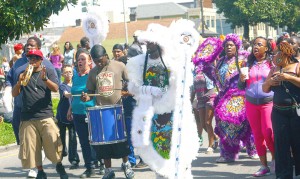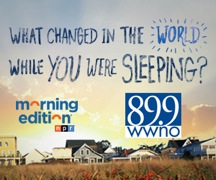Festivals and parades overtake NOLA
13th March 2017 · 0 Comments
By Geraldine Wyckoff
Contributing Writer
Congo Square New World Rhythms Festival
The connection between the African continent and New Orleans can be realized daily through our music, dance, food and cultural traditions. Its a link that despite modern sensibilities remains strong and vital. The free Congo Square New World Rhythms Festival, presented by the Jazz & Heritage Foundation on Saturday, March 18, and Sunday, March 19, at Armstrong Park, highlights the relationship with its diverse programming.
The schedule includes African dance troupes, DJ Soul Sister spinning old-school soul and funk, the ever-popular band competition among junior and senior high school students, Class Got Brass, a good-natured Mardi Gras Indian “battle,” jazz, funk and brass ensembles and more.
Two special shows, featuring artists who rarely perform with each other, mark each day. On Saturday at 2 p.m. the always engaging trumpeter/vocalist James Andrews leads his Crescent City Allstars for a show that’s often equal parts New Orleans jazz and classic rhythm and blues. For this date, Andrews invites two of this city’s finest vocalists, John Boutte and Sharon Martin, to the stage.
On Sunday, there will be a tribute to percussionist Alfred “Uganda” Roberts, who remains best known for his work with legendary pianist/vocalist/composer Professor Longhair. Shannon Powell will lead a super solid group for the performance with bassist Chris Severin, saxophonist Roderick Paulin, keyboardist Kyle Roussel and percussionist Eric Burt with the man of the hour, Uganda, also in on the jam.
“We had a lot of the same rhythm structures in our genes,” Roberts once said about Longhair with whom he performed from 1972 until Fess’ death in 1980. “He had a little rumba, mambo kind of sound with the way he played the piano,” explained Roberts, who specialized in calypso, Afro-Cuban and Caribbean styles.
As a teenager, Roberts, who began playing bongos, headed to a club on St. Bernard Avenue, La Havana Cuba, which was owned by a Cuban woman known for her well-stocked jukebox. “Me and some friends of mine would go to the club on the weekends and bring our bongos and cowbells and play with all the music on the box.”
Percussion was a natural for the young Roberts as his father, Alfred Roberts Sr., played spoons, bongos and piano for the enjoyment of friends and family. His mother, Doris Riley, was a dancer.
When Roberts was still a teenager he realized that the bongos weren’t going to cut it if he wanted to play in the local jazz clubs. That’s when he added congas to his repertoire and began sitting in at spots like Holly’s on Basin and North Villere streets. There he’d get to play with the likes of drumming greats Smokey Johnson and James Black.
Throughout the 1970s, Uganda would join the house band at SeaSaint studios whenever owner/producer Allen Toussaint needed some congas or bongos. His congas are heard on the Meters’ “Afrika” and “Hey Pocky Way.”
In 1972, New Orleans Jazz & Heritage Festival producer Quint Davis introduced Roberts to Professor Longhair. “That was the beginning of a beautiful friendship,” Uganda exclaimed. The conga player is heard on Fess’ albums Rock ‘n Roll Gumbo, Crawfish Fiesta and as a duo on The London Concert.
As a freelance musician, diversity has marked Roberts career. He was a regular at the legendary Lu & Charlie’s jazz club performing with Earl Turbinton, Willie Tee and James Black. He is there on Dr. John’s albums Goin’ Back to New Orleans and Dis, Dat or D’udder. Roberts was cast as himself for an episode in the HBO series “Treme” and regularly performs with guitarist John Mooney.
Indian Super Sunday
New Orleans will be filled with feathers on Sunday, March 19th as the New Orleans Mardi Gras Indian Council presents its Indian Super Sunday Parade. Annually held on the third Sunday in March, this year the date falls on St. Joseph’s Day, when, as the sun sets, the Black Indians traditionally come out to meet each other on the streets much as the do on Carnival Day. Though both happenings involve the Indians, they stand as quite different experiences for both participants and onlookers.
The Indian Sunday procession, which begins at 1 p.m. at A.L. Davis Park on Washington Avenue and LaSalle Street, moves in parade fashion and includes the Hot 8 and Pin Stripe brass bands as well as a division of the Young Men Olympian Benevolent Association and the Lady Buckjumpers Social Aid & Pleasure Club. Because it follows a defined route – down LaSalle to Martin Luther King Jr. Boulevard to S. Claiborne Avenue to Washington Avenue and disbands at the park – it offers easy access to catch a lot of Black Indian gangs in all their glory. On St. Joseph’s night, the Indians are more allusive, moving along both uptown and downtown streets minus definite routes or destinations. There are a few traditional spots, however, where they can usually be found like Second and Dryades streets and St. Bernard and N. Claiborne avenues.
“The majority of the tribes will do both of them,” Big Chief Howard Miller of the Creole Wild West and president of the Council says of the Indians participation in the Super Sunday parade and coming out again at night to celebrate St. Joseph’s Day.
Activities at A.L. Davis Park start at 11 a.m. with music provided by such regulars as DJ Captain Charles plus rhythm and blues, dance and rap groups. There will be rides for children and food and beverages. On Saturday, the Council also presents a Gospel Extravaganza at the park beginning at noon.
This article originally published in the March 13, 2017 print edition of The Louisiana Weekly newspaper.




